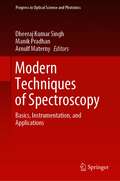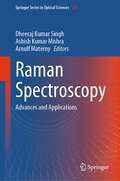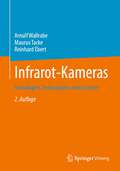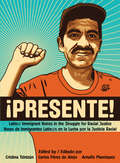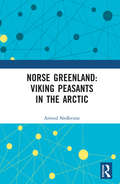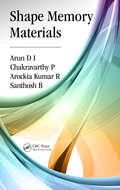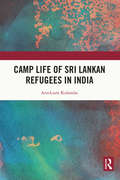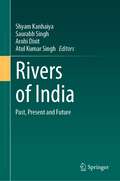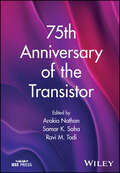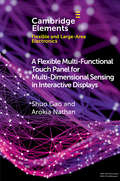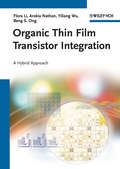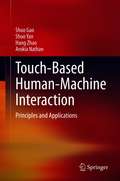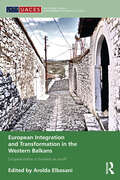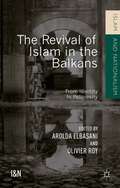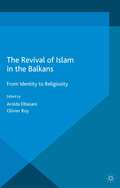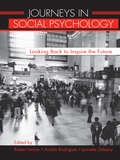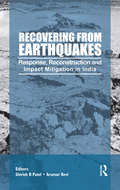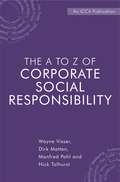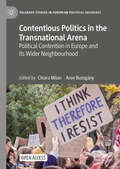- Table View
- List View
Modern Techniques of Spectroscopy: Basics, Instrumentation, and Applications (Progress in Optical Science and Photonics #13)
by Dheeraj Kumar Singh Arnulf Materny Manik PradhanThe book highlights recent developments in the field of spectroscopy by providing the readers with an updated and high-level of overview. The focus of this book is on the introduction to concepts of modern spectroscopic techniques, recent technological innovations in this field, and current examples of applications to molecules and materials relevant for academia and industry. The book will be beneficial to researchers from various branches of science and technology, and is intended to point them to modern techniques, which might be useful for their specific problems. Spectroscopic techniques, that are discussed include, UV-Visible absorption spectroscopy, XPS, Raman spectroscopy, SERS, TERS, CARS, IR absorption spectroscopy, SFG, LIBS, Quantum cascade laser (QCL) spectroscopy, fluorescence spectroscopy, ellipsometry, cavity-enhanced absorption spectroscopy, such as cavity ring-down spectroscopy (CRDS) and evanescent wave-CRDS both in gas and condensed phases, time-resolved spectroscopy etc. Applications introduced in the different chapters demonstrates the usefulness of the spectroscopic techniques for the characterization of fundamental properties of molecules, e.g. in connection with environmental impact, bio-activity, or usefulness for pharmaceutical drugs, and materials important e.g. for nano-science, nuclear chemistry, or bio-applications. The book presents how spectroscopic techniques can help to better understand substances, which have also great impact on questions of social and economic relevance (environment, alternative energy, etc.).
Raman Spectroscopy: Advances and Applications (Springer Series in Optical Sciences #248)
by Dheeraj Kumar Singh Arnulf Materny Ashish Kumar MishraThis book highlights recent advances of spectroscopic techniques based on Raman scattering. Different applications are introduced that serve as examples for the versatile use of Raman techniques. Raman spectroscopy is a marker free technique, which is capable of yielding detailed information about molecular systems in a non-destructive way. This makes it a valuable tool for, e.g., material science or medical research. The access to vibrational energy and dynamics yields fundamental insights into static and dynamical structural properties of molecules being influenced by and influencing their material science or medical research environment. The better understanding of the basic building blocks of materials helps to improve the functionality in various applications. Raman spectroscopy has become a truly interdisciplinary research tool, and the ongoing development of techniques makes it attractive for growing variety of scientific and industrial applications, which will be demonstrated in the book. While the “classical” linear spontaneous Raman spectroscopy is restricted in its applicability due to low signal intensities or the excitation of strong fluorescence background, new techniques have helped to overcome such problems. Examples, presented in the book, are surface-enhanced Raman scattering (SERS), and various associated techniques are used to drastically increase signal intensity, confocal, and tip-enhanced Raman scattering (TERS) allowing for high and even sub-diffraction limited spatial resolutions, coherent anti-Stokes Raman scattering (CARS) avoiding fluorescence background and allowing for time-resolved observations of vibrational dynamics, or hyper- and resonance Raman scattering influencing the scattering based on electronic resonances, etc.
The Ureter: A Comprehensive Review
by John Barry Arnulf Stenzl Mahmoud Abdel-Gawad Bedeir Ali-El-DeinThis book provides a contemporary panorama of advanced knowledge on the ureter. It covers basic knowledge and recent advances in a range of well-organized topics such as stone diagnosis, treatment, ureteroscopy, laser technology, reconstruction, oncology, trauma, embryology and radiology of the ureter. As shown in the table of contents, the book is written by a group of urology and non-urologic experts in their field and is enriched with many illustrations and summary tables. The 26 chapters are each dedicated to specific topics related to ureteral pathology and abnormality as well as diagnostic steps and treatment. Rare diseases that may affect the ureter are also included. Additionally there are basic educational materials that will be suitable for teaching, tutorials as well as electronic supplementary video clips and powerpoint presentations for demonstrations. The future perspectives of ureteral diseases, endoscopic and laparoscopic handling are covered. Fellows and medical professionals will find this a useful book with up-to-date knowledge of the various diseases and to demonstrate specific recent techniques involving stones, strictures and other pathologies of the ureter. Additional questions via app: Download the Springer Nature Flashcards app for free and use exclusive additional material to test your knowledge.
Infrarot-Kameras: Grundlagen, Technologien und Systeme
by Arnulf Wallrabe Maurus Tacke Reinhard EbertIn vielen Bereichen der kommerziellen Technik, und ganz besonders in der Wehrtechnik, gewinnt die Infrarot-Sensorik an Bedeutung. Für die Nachtsichttechnik kann man sich zwei verschiedene Prinzipien zunutze machen: 1. Bildverstärkergeräte, die darauf beruhen, dass häufig nachts eine geringe Resthelligkeit vorhanden ist; 2. Wärmebildgeräte nutzen dagegen die von jedem Körper naturgesetzlich im Infraroten ausgesendete Wärmestrahlung, die ohne jegliche Beleuchtung auskommt. Dieses Buch ist für alle geschrieben, die sich in das noch relativ junge Gebiet der Wärmebildtechnik einarbeiten, wobei es sowohl für Anwender von Wärmebildgeräten als auch für Naturwissenschaftler und Ingenieure, die sich über diese Technik informieren oder selbst auf diesem Gebiet arbeiten wollen, von Nutzen ist. Es folgen technische Realisierungen, Konzepte und Konstruktionen von Geräten. Nutzen daran hat auch der Offizier an nachtsichtfähigen Waffensystemen. Es ist zur Zeit das einzige deutschsprachige Buch zum Thema Höchstleistungs-Wärmebildgeräte.
Presente!: Latin@ Immigrant Voices in the Struggle for Racial Justice / Voces Inmigranted Latinas en la Lucha por la Justicia Racial
by Juan González Arnulfo Manríquez Cristina Tzintzún Carlos Pérez de AlejoRead the media coverage of the increasingly heated debate around immigration reform in the United States: two dominant narratives emerge. From Lou Dobbs to Sean Hannity, commentators on the right have crafted an image rooted in fear, demonizing undocumented immigrants as a threat to national security and raising the specter of a deliberate "browning of America." Left-leaning journalists, on the other hand, foreground victimization, emphasizing the plight of immigrants, stripping them of their agency. Neither captures the range of experiences within undocumented immigrant communities, and both fail to see immigrants as active participants in their own struggle for racial and economic justice.Presente! offers a rare perspective on the immigrant-rights movement, written by immigrant workers themselves. Including a range of essays exploring the intersection of race, class, and immigration in the United States, this anthology challenges its readers to move beyond a "legalization-only" framework and embrace a broader vision for social justice organizing embodied in the work of grassroots organizations across the country resisting state repression, cultivating solidarity, and building alternative models for progressive social change. Offered in a dual-language edition, with a foreword by Democracy Now! co-host Juan Gonzáles.Cristina Tzintzún is the executive director of Workers Defense Project, a Texas based workers' rights organization.Carlos Pérez de Alejo is the executive director of Cooperation Texas, an organization dedicated to the creation of sustainable jobs through the development, support, and promotion of worker-owned cooperatives.Arnulfo Manríquez is an organizer at Workers Defense Project, where he organizes immigrant construction workers to defend their labor and human rights.
Norse Greenland: Viking Peasants In The Arctic
by Arnved NedkvitneHow could a community of 2000–3000 Viking peasants survive in Arctic Greenland for 430 years (ca. 985–1415), and why did they finally disappear? European agriculture in an Arctic environment encountered serious ecological challenges. The Norse peasants faced these challenges by adapting agricultural practices they had learned from the Atlantic and North Sea coast of Norway. Norse Greenland was the stepping stone for the Europeans who first discovered America and settled briefly in Newfoundland ca. AD 1000. The community had a global significance which surpassed its modest size. In the last decades scholars have been nearly unanimous in emphasising that long-term climatic and environmental changes created a situation where Norse agriculture was no longer sustainable and the community was ruined. A secondary hypothesis has focused on ethnic confrontations between Norse peasants and Inuit hunters. In the last decades ethnic violence has been on the rise in Eastern Europe, the Middle East and parts of Africa. In some cases it has degenerated into ethnic cleansing. This has strengthened the interest in ethnic violence in past societies. Challenging traditional hypotheses is a source of progress in all science. The present book does this on the basis of relevant written and archaeological material respecting the methodology of both sciences.
Shape Memory Materials
by Chakravarthy P Arockia Kumar R Santhosh B Arun D IThis work addresses the basic principles, synthesis / fabrication and applications of smart materials, specifically shape memory materials <P><P>Based on origin, the mechanisms of transformations vary in different shape memory materials and are discussed in different chapters under titles of shape memory alloys, ceramics, gels and polymers <P><P>Complete coverage of composite formation with polymer matrix and reinforcement filler conductive materials with examples
Camp Life of Sri Lankan Refugees in India
by R. Shankar Arockiam KulandaiThis book looks at the mass migration of refugees into India during the Sri Lankan civil war, the lives of the displaced people in refugee camps and the politics around the issue. It analyses the citizenship policies in India and the social, economic, psychological, political and legal implications of the laws on the lives of Tamil refugees. The book examines the protracted refugee situations in other parts of the globe to build a comparative case study of the Sri Lankan refugees. It delves into the stories and lives of these people in their home country before the war, the crisis and trauma of war, and the experience of living in refugee camps. The volume looks at the role played by the state government of Tamil Nadu, the Indian government and NGOs towards the protection of these refugees and state of facilities for health, safety, education, among others in the camps. It also discusses the possibility of integration and solutions like voluntary repatriation or the granting of citizenship for the people living in these camps. This book will be a useful resource for scholars and researchers of refugee and border studies, human rights, political studies, international relations, political sociology, peace and conflict studies, war and strategic studies, and South Asian studies.
Role of Birds in Transmitting Zoonotic Pathogens (Livestock Diseases and Management)
by Yashpal Singh Malik Arockiasamy Arun Prince Milton Sandeep Ghatak Souvik GhoshZoonotic diseases pose a serious threat to global health and economy. Domestic and wild birds play crucial roles in transmission and spread of important zoonotic pathogens, with significant implications on human and avian health. Although zoonotic diseases have been extensively studied, information on various aspects of avian zoonotic pathogens have not been revisited or revised to any great extent. This book is a comprehensive and updated compilation of important zoonotic diseases that are transmitted by domestic and wild birds, and consists of 21 chapters that meticulously describe the (i) etiology and evolution, (ii) complex epidemiology, such as migration pathways in context of disease transmission, (iii) pathogenesis, (iv) clinical signs and necropsy findings, (v) diagnostics including latest molecular assays, and (vi) preventative and control strategies, with an emphasis on therapeutics and prophylaxis, of important zoonotic pathogens (bacterial, fungal, parasitic and viral) of avian origin in humans and birds. Each chapter is aptly supported by interactive tables and figures, and features an updated reference section. This book aims to create awareness and enlighten students of veterinary and human medicine on the role of birds in zoonoses, and would serve as a useful reference for working veterinarians, human doctors, and public health experts.
Rivers of India: Past, Present and Future
by Atul Kumar Singh Saurabh Singh Shyam Kanhaiya Arohi DixitThis volume presents geological, geographical, environmental, and agriculture related studies on rivers, focusing on basins of the three geomorphic divisions of India, i.e. peninsular India, Indo-Gangetic plain and extra-peninsular India. The book compiles data on both the small and large river systems of India, the large rivers include Jhelum, Ghaghara, Narmada, Son, Krishna and Godavari; and the small scale, rain-fed and groundwater-fed rivers such as Gomti have been studied. The chapters comprehensively provide assessments of geomorphological aspects, river sediment supply, clean water availability for human population, ground water recharge, flood management and irrigation. The information presented in this book will appeal to students, teachers, researchers and planners engaged in river development, management and conservation.
75th Anniversary of the Transistor
by Arokia Nathan Samar K. Saha Ravi M. Todi75th Anniversary of the Transistor 75th anniversary commemorative volume reflecting the transistor's development since inception to current state of the art 75th Anniversary of the Transistor is a commemorative anniversary volume to celebrate the invention of the transistor. The anniversary volume was conceived by the IEEE Electron Devices Society (EDS) to provide comprehensive yet compact coverage of the historical perspectives underlying the invention of the transistor and its subsequent evolution into a multitude of integration and manufacturing technologies and applications. The book reflects the transistor's development since inception to the current state of the art that continues to enable scaling to very large-scale integrated circuits of higher functionality and speed. The stages in this evolution covered are in chronological order to reflect historical developments. Narratives and experiences are provided by a select number of venerated industry and academic leaders, and retired veterans, of the semiconductor industry. 75th Anniversary of the Transistor highlights: Historical perspectives of the state-of-the-art pre-solid-state-transistor world (pre-1947) leading to the invention of the transistor Invention of the bipolar junction transistor (BJT) and analytical formulations by Shockley (1948) and their impact on the semiconductor industry Large scale integration, Moore's Law (1965) and transistor scaling (1974), and MOS/LSI, including flash memories — SRAMs, DRAMs (1963), and the Toshiba NAND flash memory (1989) Image sensors (1986), including charge-coupled devices, and related microsensor applications With comprehensive yet succinct and accessible coverage of one of the cornerstones of modern technology, 75th Anniversary of the Transistor is an essential reference for engineers, researchers, and undergraduate students looking for historical perspective from leaders in the field.
A Flexible Multi-Functional Touch Panel for Multi-Dimensional Sensing in Interactive Displays (Elements in Flexible and Large-Area Electronics)
by Arokia Nathan Shuo GaoTouch screen panels (TSPs) have become an integral part of modern-day lifestyle. To enhance user experience, attributes such as form-factor flexibility, multi-dimensional sensing, low power consumption and low cost have become highly desirable. This Element addresses the design of multi-functional TSPs with integrated concurrent capture of ubiquitous capacitive touch signals and force information. It compares and contrasts interactive technologies and presents design considerations for multi-dimensional touch screens with high detection sensitivity, accuracy and resolution.
Organic Thin Film Transistor Integration: A Hybrid Approach
by Arokia Nathan Beng S. Ong Yiliang Wu Flora LiResearch on organic electronics (or plastic electronics) is driven by the need to create systems that are lightweight, unbreakable, and mechanically flexible. With the remarkable improvement in the performance of organic semiconductor materials during the past few decades, organic electronics appeal to innovative, practical, and broad-impact applications requiring large-area coverage, mechanical flexibility, low-temperature processing, and low cost. Thus, organic electronics appeal to a broad range of electronic devices and products including transistors, diodes, sensors, solar cells, lighting, displays, and electronic identification and tracking devices A number of commercial opportunities have been identified for organic thin film transistors (OTFTs), ranging from flexible displays, electronic paper, radio-frequency identification (RFID) tags, smart cards, to low-cost disposable electronic products, and more are continually being invented as the technology matures. The potential applications for "plastic electronics" are huge but several technological hurdles must be overcome. In many of these applications, transistor serves as a fundamental building block to implement the necessary electronic functionality. Hence, research in organic thin film transistors (OTFTs) or organic field effect transistors (OFETs) is eminently pertinent to the development and realization of organic electronics. This book presents a comprehensive investigation of the production and application of a variety of polymer based transistor devices and circuits. It begins with a detailed overview of Organic Thin Film Transistors (OTFTs) and discusses the various possible fabrication methods reported so far. This is followed by two major sections on the choice, optimization and implementation of the gate dielectric material to be used. Details of the effects of processing on the efficiency of the contacts are then provided. The book concludes with a chapter on the integration of such devices to produce a variety of OTFT based circuits and systems. The key objective is to examine strategies to exploit existing materials and techniques to advance OTFT technology in device performance, device manufacture, and device integration. Finally, the collective knowledge from these investigations facilitates the integration of OTFTs into organic circuits, which is expected to contribute to the development of new generation of all-organic displays for communication devices and other pertinent applications. Overall, a major outcome of this work is that it provides an economical means for organic transistor and circuit integration, by enabling the use of a well-established PECVD infrastructure, while not compromising the performance of electronics. The techniques established here are not limited to use in OTFTs only; the organic semiconductor and SiNx combination can be used in other device structures (e.g., sensors, diodes, photovoltaics). Furthermore, the approach and strategy used for interface optimization can be extended to the development of other materials systems.
Thin Film Transistor Circuits and Systems
by Reza Chaji Arokia NathanProviding a reliable and consolidated treatment of the principles behind large-area electronics, this book provides a comprehensive review of the design challenges associated with building circuits and systems from thin-film transistors. The authors describe the architecture, fabrication and design considerations for the principal types of TFT and their numerous applications. The practicalities of device non-ideality are also addressed and the specific design considerations necessitated by instabilities and non-uniformities in existing fabrication technologies. Containing device-circuit information, discussion of electronic solutions that compensate for material deficiencies, and design methodologies applicable to a wide variety of organic and inorganic disordered materials, this is an essential reference for all researchers, circuit and device engineers working on large-area electronics.
Touch-Based Human-Machine Interaction: Principles and Applications
by Arokia Nathan Shuo Gao Shuo Yan Hang ZhaoThis textbook presents a comprehensive treatment of touch technologies, explaining current mainstream and new contact/non-contact based human-machine interactivity (HMI) techniques, which are ubiquitous in modern electronic devices and allow machines to exchange information with users in an efficient and reliable manner. The book provides a detailed study of HMI working principles and practical product examples. Haptic, which has become essential for users to gain immersive experience, is also discussed. The book concludes with an overview of novel applications enabled by emerging technologies, such as advanced materials, virtual reality and machine learning, providing a roadmap for possible development trends for touch interactivities. The book can be used as a graduate text for students in display and touch interface technology courses in electrical and computer engineering, and a professional reference for researchers, practicing engineers, and product designers working in broad areas of engineering. Helps students understand the working principles of current touch technologies;Offers design considerations for prototypes and products;Provides seamless connectivity between broad subject areas involved in HMI, including material science, microelectronic circuits, mechanical engineering, and digital signal processing.
Nutraceuticals for Alzheimer's Disease: A Promising Therapeutic Approach (Nutritional Neurosciences)
by Arokiasamy Justin Thenmozhi Thamilarasan ManivasagamThis book reviews the potential effect of diet modification, lipids, and carbohydrate consumptions, vitamin supplementation, antioxidants, and nutraceuticals in the prevention and management of Alzheimer's disease. The initial chapter of the book presents the pathophysiological mechanisms, risk factors, genetic predisposition, disease diagnosis, pathology, and current treatment strategies against Alzheimer's disease. It also highlights recent developments in exploring novel compounds for the prevention and treatment of Alzheimer's disease. Subsequently, it highlights the therapeutic effect and regulation of molecular targets by natural compounds. The book discusses the potential of natural compounds in inhibiting the formation and deposition of Aβ peptides. It examines the natural compounds in modulating intracellular signaling molecules and enzymes involved in the pathogenesis of Alzheimer's disease. In summary, this book helps understand the role of natural compounds as a therapeutic approach in amelioration and preventing detrimental effects of Alzheimer's disease.
European Integration and Transformation in the Western Balkans: Europeanization or Business as Usual? (Routledge/UACES Contemporary European Studies)
by Arolda ElbasaniThe book investigates the scope and limitations of the transformative power of EU enlargement in the Western Balkans. The extension of EU enlargement policy to the region has generated high expectations that enlargement will regulate democratic institution-building and foster reform, much as it did in Central and Eastern Europe. However, there is very little research on whether and how unfavourable domestic conditions might mitigate the transformative power of the EU. This volume investigates the role of domestic factors, identifying ‘stateness’ as the missing link between the assumed transformative power of the EU and the actual capacity to adopt EU rules across the region. Including chapters on Croatia, Serbia, Macedonia, Albania, Kosovo, and Bosnia-Herzegovina, leading scholars in the field offer up-to-date comparative analysis of key areas of institutional and policy reform; including state bureaucracy, rule of law, electoral management, environmental governance, cooperation with the International Court of Justice, economic liberalization and foreign policy. Looking to the future and the implications for policy change, European Integration and Transformation in the Western Balkans provides a new theoretical and empirical focus on this little understood area. The book will be of interest to scholars and students of EU politics, comparative democratisation, post-communist transitions and Balkan area studies.
The Revival of Islam in the Balkans: From Identity to Religiosity (Islam And Nationalism)
by Olivier Roy Arolda ElbasaniThis book shifts analytical focus from macro-politicization and securitization of Islam to Muslims' choices, practices and public expressions of faith. An empirically rich analysis, the book provides rich cross-country evidence on the emergence of autonomous faith communities as well as the evolution of Islam in the broader European context.
The Revival of Islam in the Balkans: From Identity to Religiosity (Islam and Nationalism)
by Olivier Roy Arolda ElbasaniThis book shifts analytical focus from macro-politicization and securitization of Islam to Muslims' choices, practices and public expressions of faith. An empirically rich analysis, the book provides rich cross-country evidence on the emergence of autonomous faith communities as well as the evolution of Islam in the broader European context.
Journeys in Social Psychology: Looking Back to Inspire the Future
by Robert Levine Aroldo Rodrigues Lynnette ZeleznyThis volume consists of personal narrative accounts of the career journeys of some of the world's most eminent social psychologists. Each contributing psychologist is an esteemed scholar, an excellent writer, and has a story to tell. Together, the contributions cover a time range from Morton Deutsch to today, and touch upon virtually every important movement and person in the history of academic social psychology. This book provides a fascinating insight into the development of outstanding academic careers and will be a source of inspiration to seasoned researchers and beginning students alike, in the fields of social psychology, history of psychology, and beyond.
Recovering from Earthquakes: Response, Reconstruction and Impact Mitigation in India
by Shirish B Patel Aromar ReviEarthquakes come without warming, and often cause massive devastation, resulting not only in the loss of property but also of lives. Many of the survivors suffer from intense and lasting psychological trauma. This book covers the experience of recent earthquakes in India, and what has been learnt (and what we have failed to learn) in the process of managing the aftermath in each case. This includes immediate medical attention, long-term mental health care, and the reconstruction of housing and infrastructure in both rural and urban areas. The experiences of the contributors, many of whom have actively contributed their expertise to disaster management and recovery, help us understand what problems require a swift response and which aspects should be based on detailed analyses keeping in mind local conditions. Reconstruction is seen as offering an opportunity to rebuild society such that all sections of the population are empowered and brought into the community’s decision-making process. It is also an opportunity to develop construction techniques that are suited to local materials and skills but are also more earthquake-resistant than the old. And finally, there is the realisation that the best first responders are local community groups which need to be nurtured, and trained in crisis management and risk mitigation.
Modern Essentials: A Contemporary Guide to the Therapeutic Use of Essential Oils,Sixth Edition
by AromatoolsModern Essentials: A Contemporary Guide to the Therapeutic Use of Essential Oils is perfect for anyone looking to know more about essential oils and how they can be used in everyday life. Whether you are a beginner or a long-time essential oil user, this book is designed for you.
The A to Z of Corporate Social Responsibility
by Matten Mr Dirk Huble Sandra S. Hennigfeld Judith Ghebremariam Aron B Hmer Katja Tolhurst Mr Nick Pohl Mr Manfred Visser Mr WayneThis is the world's first complete reference on CSR, compiled by the Institute for Corporate Cultural Affairs (the ICCA). The entries have been written by leading experts, leading global thinkers and CSR practitioners. In these pages lie the answers to questions such as: What do we mean by CSR? In what way are organizations viewed as citizens of the countries in which they operate? How does a company know when it is operating in a sustainable way What is ethical investment? The reference also lists and describes the most important organizations and landmarks in the field of CSR. The book comprises 339 terms, which are split into core concepts, key words and definitions to form the standard reference for managers, academics, teachers, students, officials and volunteers in the field of CSR. This is a timely and innovative contribution to the field of Corporate Social Responsibility - the definitive terminology reference on CSR, business society relations and the organizations and standards in the field.
Contentious Politics in the Transnational Arena: Political Contention in Europe and its Wider Neighbourhood (Palgrave Studies in European Political Sociology)
by Chiara Milan Aron BuzogányThis Open Access book investigates the transnational dimension of activism — exploring how and why non-state actors scale up contention from the local to the transnational arena, how they translate their grievances and claims into the transnational arena, and how they organize across borders. Moving beyond the analysis of individual campaigns, or a single-country or single-issue focus, which are already well represented in the literature, this volume takes a comprehensive approach. It investigates transnational activities across various policy fields and their respective transnational arenas of contention — namely migration, labour struggles, human rights, and environmental/climate justice — across a range of geographic contexts. Drawing on extensive fieldwork, the contributions in this volume examine cases of transnational contention spanning the EU and its broader neighborhood, from the Western Balkans to the South Caucasus and the Mediterranean. Focusing on European spaces as the arena where civil society actors mobilize, this volume offers insights into their diverse repertoires of contention and discursive strategies, and how they refer to the European Union as the direct or indirect target of their claims. Key cases include grassroots movements, NGO campaigns, pro-European forces, Eurosceptic parties, healthcare and climate justice activism, and the organizational dynamics surrounding migration-related contentious politics. Offering guidelines for future research on civil society actors in the EU and its neighbourhood, this volume is essential reading for scholars and students of political sociology, political science, European studies, as well as practitioners and policy makers concerned with the future of civil society activism in the transnational arena.
Raising the Bar: Creating Value with the UN Global Compact
by Aron Cramer Claude Fussler Sebastian van der VegtThis book, produced by a unique team of business experts and UN agencies, is designed to fill a critical void-between the support of more than 1,000 organisations for the globally recognised Principles of the United Nations Global Compact and the need for this support to be translated into the day-to-day running of business to create value and improve performance. The ten Global Compact Principles cover human rights, labour standards, environmental responsibility and anti-corruption. But what does it mean to implement the Compact and its principles? How can the broad brush strokes of the Principles form the basis of management change? And how should companies establish benchmarks and performance indicators for implementation? For many companies, the journey is just starting. How can they ensure that they align with the Global Compact in ways that continue to reward their other business objectives? How should they embrace and capitalise on the Global Compact's potential for bringing together business, the public sector, trade unions and civil society in new partnerships? The aim of this book is to answer these questions by providing a performance model clearly grounded on the total quality management approach to assist businesses in putting the Global Compact into practice. Raising the Bar collects together and categorises a wealth of corporate responsibility tools, good practice and case studies in a structure familiar to anyone aware of business excellence models and demonstrates that values create value-leadership commitment to the Global Compact can impact both the boardroom and the shop floor, public image and balance sheet. Full of graphics and designed with accessibility in mind, the book will be a goldmine for managers looking for inspiration on how their businesses can be good corporate citizens and real proof that good business is also good for the bottom line.
